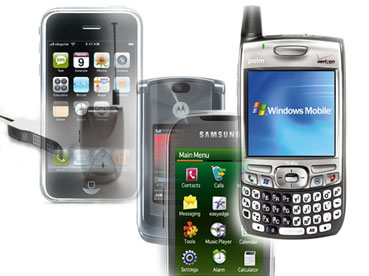



|
The earliest large scale communication network using pigeons as messengers was established in Syria and Persia about 5th Century BC. Source |
 |
|
In a Nutshell: Technology is getting smaller, faster, more mobile and more converged. What this means is that devices like SmartPhones can take calls, e-mail, check the Internet, text and do many other things like tracking global positioning (GPS). Standalone GPS devices may meet their demise in 2010. Meanwhile, Apple executives say the iPhone is cannibalizing the iPod: Why carry two devices when you only need one?" (Pete Cashmore, CNN) |
|
| Definition of Mobile Technology | |
|
In a Nutshell: Mobile technology is a collective term used to describe the various cellular communication technologies. Mobile CDMA technology has evolved quite rapidly over the past few years. Many experts argue that the future of computer technology rests in mobile/wireless computing. Source Mobile devices can be enabled to use a variety of communications technologies such as:
|
|
| History of Mobile Technology | |
|
In a Nutshell: The history of mobile phones begins with early efforts to develop radio telephone technology and from two-way radios in vehicles and continues through to emergence of the modern mobile phone and its associated services. 1910 - Lars Magnus Ericsson installed a telephone in his car while travelling across the country, he would stop at a place where telephone lines were accessible and using a pair of long electric wires he could connect to the national telephone network. 1940s
- Motorola developed a backpacked two-way radio, the Walkie-Talkie
and later developed a large hand-held two-way radio for the US
military.
1950s - ships on the Rhine were among the first to use radio telephony with an untrained end customer as a user. 1960's - The Swedish electrical engineer Östen Mäkitalo is considered the father of the NMT system. In 1970 Amos E. Joel, Jr., another Bell Labs engineer, invented an automatic "call handoff" system to allow mobile phones to move through several cell areas during a single conversation without loss of conversation. 1970's - The FCC approved an AT&T proposal in 1982 for Advanced Mobile Phone System (AMPS) and allocated frequencies in the 824–894 MHz band. Analog AMPS was superseded by Digital AMPS in 1990. Motorola employee Dr. Martin Cooper placed a call to Dr. Joel S. Engel, head of research at AT&T's Bell Labs, while walking the streets of New York City talking on the first Motorola DynaTAC prototype in front of reporters. 1990's, the 'second generation' (2G) mobile phone systems emerged, primarily using the GSM standard. In 1991 the first GSM network (Radiolinja) opened in Finland. In 1993 the first person-to-person SMS text message was sent in Finland. 2000's - Finland was also the first country where advertising appeared on the mobile phone when a free daily news headline service on SMS text messaging was launched, sponsored by advertising. Source The Future of Mobile Technology - Source
|
|
| Examples of Mobile Technology | |
|
|
| The Benefits of Mobile Tech | |
Health-Related: Community health workers in the Millennium Village of Sauri, Western Kenya, are using mobile technology in this remote rural area to track preventable disease and improve maternal and child health. See Video Here. BUSINESSWEEK - The market, known as mobile or m-health, spans everything from text messaging services to remind people to take medications to implants that monitor heart patients. There are even pills with edible computer chips; the chips send signals to a skin patch, which in turn transmits data to a doctor's cell phone or computer. The information helps doctors track when patients take their medicines and whether there are adverse reactions. "Mobile has the potential to revolutionize the health-care system by increasing efficiency, lowering costs, expanding access to care, and improving patient outcomes," says Alessio Ascari, who leads McKinsey's mobile-health-care initiative from Milan. Source |
|
| The Negatives | |
|
|
| The Basics of Getting Mobile Tech (For example, a phone) | |
|
|
| More Resources | |
Sarah
McNabb - CMNS 545: Communication & Technology - 2010 |





